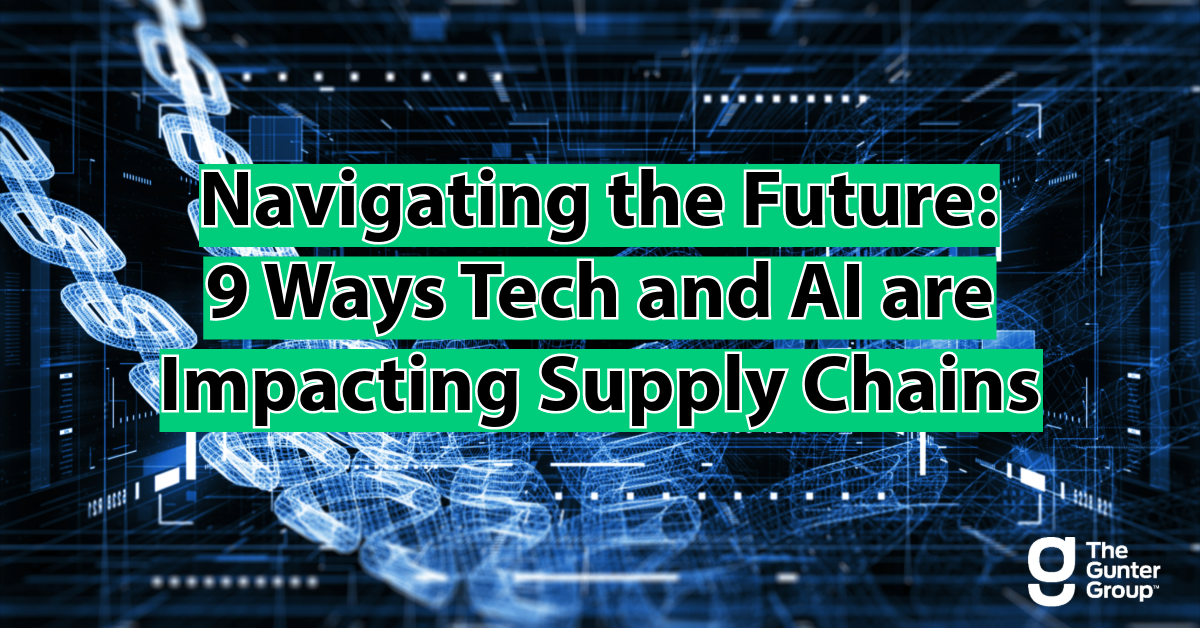Supply chains are the backbone of the global economy, orchestrating the seamless flow from manufacturers to consumers. They are intricate networks covering vendor selection, raw materials, manufacturing, warehousing, and end-user delivery. Beyond meeting consumer demands, they drive economic growth, create jobs, drive profitability and brand share, and fuel innovation.
In crises like the Covid-19 Pandemic, resilient supply chains shine. Today’s dynamic business landscape demands agile responses to tech shifts, changing preferences, and disruptions. Global supply chains, complex and swift, navigate regulatory changes. Rapid evolution enhances efficiency and cost-effectiveness, enabling organizations to meet demands and conquer challenges. Innovation and data-driven insights are paramount for staying competitive.
In this series of blog articles we will explore the leading trends shaping future Supply Chains. This first article will discuss The Impact of Technology on Supply Chains, with subsequent posts covering the following topics:
– Supply Chain Operations: trends impacting functions such as manufacturing, warehousing and logistics as well as trends in automation.
– Supply Chain Optimization: optimizations such as supply collaboration, e-commerce, data & analytics and supply chain flexibility & agility. The post will also discuss sustainable supply chains.
– People in Supply Chain: the “people” impact resulting from wide-scale changes and how an organization can prepare people for this change.
– Supply Chain Business Environment, Supply Chain Resilience and Change Management: what organizations can expect going forward and how this will impact their supply chains.
Trends in Supply Chain: The Impact of Technology and AI on Supply Chain
In the landscape of global commerce, the importance technology will play in the future of supply chains is paramount. Artificial Intelligence (AI), Cybersecurity, and advanced tools are emerging as pivotal technological components all working together to develop Digital Supply Chains:
- AI brings unprecedented efficiency to supply chain management by optimizing processes, predicting demand patterns, and enhancing decision-making through data-driven insights. Its ability to analyze vast datasets enables organizations to streamline operations, minimize costs, and respond swiftly to market fluctuations.
- Advanced tools, such as Digital Supply Chain Twins, Supply Chain Control Towers, Blockchain and the Internet of Things (IoT) devices foster transparency, traceability, and real-time monitoring, promoting a resilient and agile supply chain.
- Robust cybersecurity measures are indispensable in safeguarding sensitive information, assuring the integrity of transactions and mitigating the risks associated with increasingly complex digital ecosystems.
As technology continues to evolve, its integration into the supply chain not only enhances operational efficiency but also fortifies the sector against emerging challenges, ensuring a future-ready and adaptive foundation for global commerce.

AI is providing exciting advancements in supply chains, as exhibited from the following examples:
- Supply Chain Mapping: AI-driven supply chain mapping involves utilizing artificial intelligence algorithms to analyze and visualize the end-to-end flow of goods, information, and processes within a supply chain, offering comprehensive insights and optimization opportunities. Wal-Mart, Tyson Foods, Maersk and Siemens are real world examples of companies using Supply Chain Mapping to find and engage with alternate suppliers as well as pre-qualify alternate suppliers.
- Machine Learning and Predictive Analytics: Machine learning in the supply chain applies algorithms to learn from data, predict trends, and optimize decision-making. This boosts forecasting accuracy, enhances inventory management, and improves overall operational efficiency. Continuous adaptation to new information ensures a responsive and agile supply chain. Companies like DHL, Maersk, UPS, and Vibronyx Inc. leverage AI-driven predictive analytics to analyze historical data, identify patterns, and forecast future trends, enabling proactive decision-making, risk mitigation, and operational optimization.
- Operational Performance: Specific examples of how AI can optimize operational performance include AI-powered forecasting that can equip operations with improved intelligence to reduce demand-supply mismatches, AI-based algorithms that automate goods retrieval from warehouses for smooth order fulfillment and chatbots to improve customer service. Additional examples include solutions supporting fleet management platforms that optimize routes for a faster and more economical movement of goods and AI-powered autonomous vehicles that can reduce driver costs.
Along with the importance of AI to the future of supply chains, there are various advanced tools, some of which will work hand-in-hand with AI capabilities that will play an important role in supply chains:
- Digital Supply Chain Twin: A Digital Supply Chain Twin is a virtual simulation of a physical supply chain that uses real-time data and artificial intelligence to analyze and predict its behavior. It helps organizations test scenarios, model different options, and understand the impact of decisions and disruptions on network operations. Real world examples of companies utilizing Digital Supply Chains include Google, FedEx, DHL, GE, Rolls-Royce and Pratt & Whitney.
- Supply Chain Control Tower: A Supply Chain Control Tower is a centralized platform that provides end-to-end visibility and real-time monitoring of supply chain activities spanning areas such as transportation, warehousing, inventory management and manufacturing. This enables proactive decision-making, issue resolution, and optimization of logistics processes. Real world examples of companies utilizing Supply Chain Control Towers include Coca-Cola, IBM, Nestle, Procter & Gamble and Unilever.
- Blockchain: Blockchain in the context of the supply chain acts as an immutable and transparent digital ledger, enabling secure and traceable recording of transactions, shipments, and processes across a decentralized network, thereby enhancing trust, reducing fraud, and optimizing transparency throughout the supply chain ecosystem. This technology ensures that each participant in the supply chain has access to a consistent and incorruptible record of transactions, fostering efficiency and accountability. Real world examples of companies utilizing Blockchain include Walmart to track products back to their origin, British Airways and Maersk to manage cargo, and Nestle for their Supply Chain management.
- Internet of Things: The Internet of Things (IoT) in the supply chain embeds sensors and connected devices for real-time tracking and data collection, fostering increased visibility and efficiency. This enables proactive decision-making, optimizing overall supply chain performance. Facilitating seamless communication between devices, IoT enhances management, provides actionable insights, reduces delays, and offers a comprehensive understanding of the entire supply chain ecosystem. Companies like Amazon, Volvo, and Maersk Line use IoT for warehouse management, monitoring car part shipments, and tracking containers globally.
- Smart Logistics: Smart Logistics integrates cutting-edge technologies such as IoT sensors, data analytics, and automation to optimize the entire logistics process, enabling real-time monitoring, predictive analytics, and efficient decision-making for improved supply chain performance. Real world examples of companies utilizing Smart Logistics include Amazon using Kiva robots to move goods efficiently across its fulfillment centers, DHL for better inventory management and forecasting, and Chronicled to automate traceability and instantaneously approve financial transactions in the shipping industry.
- Cybersecurity: Cybersecurity is set to shape the future of the supply chain industry with key trends. The integration of AI and machine learning enhances adaptability to evolving threats. Blockchain technology fosters transparency and traceability. The rise of quantum computing prompts the development of quantum-resistant encryption. Convergence with IoT devices demands robust security protocols. Emphasizing collaboration and adopting a proactive, risk-based approach are crucial for staying ahead of cyber threats as supply chains digitize.
To reiterate the message at the beginning of this post, supply chains must be agile and adaptable to thrive. Enhancements in technology, such as in the tools listed above will play a significant role in allowing your supply chain to meet future challenges. In addition, as organizations begin utilizing these tools, they will also need to ask themselves the following questions to assess their readiness for implementation:
- What is the intention, or future state design of the supply chain, and will the implementation of these tools get the organization to where they need to go?
- Is the organization ready to implement, and if not what is needed to be ready?
- What is the pre-work needed by the organization to use various AI tools across their supply chain. Pre-work will span areas such as data preparation, machine learning pre-work, capital investment planning and training.
Today’s supply chains are far from the simplicity of a few years ago, as captured in this post showcasing key technological trends. At The Gunter Group, our team of consultants has extensive experience spanning numerous industries and organizations. We’re poised to offer valuable guidance, address your questions, and help develop supply chains that tackle the diverse challenges of the future.
Stay tuned for our next post, delving into the intricacies of Supply Chain Operations.


